The Ultimate Guide to Hoi An’s Coconut Basket Boat Tour
8 min readA quick search of Hoi An online, and you’ll undoubtedly see the colorful, circular basket boats floating (or crazily spinning) amid the tranquil waterways of Bay Mau’s lush green coconut...
The post Discovering the Calm (& Chaos) of Hoi An’s Coconut Basket Boat Tour appeared first on Bucketlist Bri.
Disclosure: This post may contain affiliate links, which earn me a small commission from bookings at no extra cost to you. Thank you for reading and supporting my blog!
A quick search of Hoi An online, and you’ll undoubtedly see the colorful, circular basket boats floating (or crazily spinning) amid the tranquil waterways of Bay Mau’s lush green coconut forest grove.
It looks alluring and beautiful and peaceful, right?
Ehh… Hoi An’s famous coconut basket boat ride is many things, but it’s not exactly what you expect it to be.

This “must-do” tour often graces social media because of—what I call—its chaotic side (the spinning “basket boat dances” are what most people come for).
While social media can help boost tourism to an area, it can also mask the deep cultural significance and history behind centuries-old traditions.
Such is the case for Hoi An’s social media-famous circular basket boats, called coracles, locally known as thuyền thúng.

Today, the basket boat rides in Hoi An’s Bay Mau coconut forest area have become a popular tourist attraction, offering visitors a glimpse into local fishing practices and livelihoods.
At first, I quickly defaulted to criticizing the Gangnam Style-blaring speakers—a seemingly inseparable part of the basket boat tour—until I stepped back to see the larger picture.
Tourism plays a massive role in preserving cultural traditions, and the basket boats, a significant part of Hoi An’s history, admittedly do that (or, at least, try).
In this guide, I’m sharing everything you need to know and expect from the coconut basket boats of Hoi An in hopes that you can enjoy this experience and walk away with a deeper understanding of this popular thing to do.
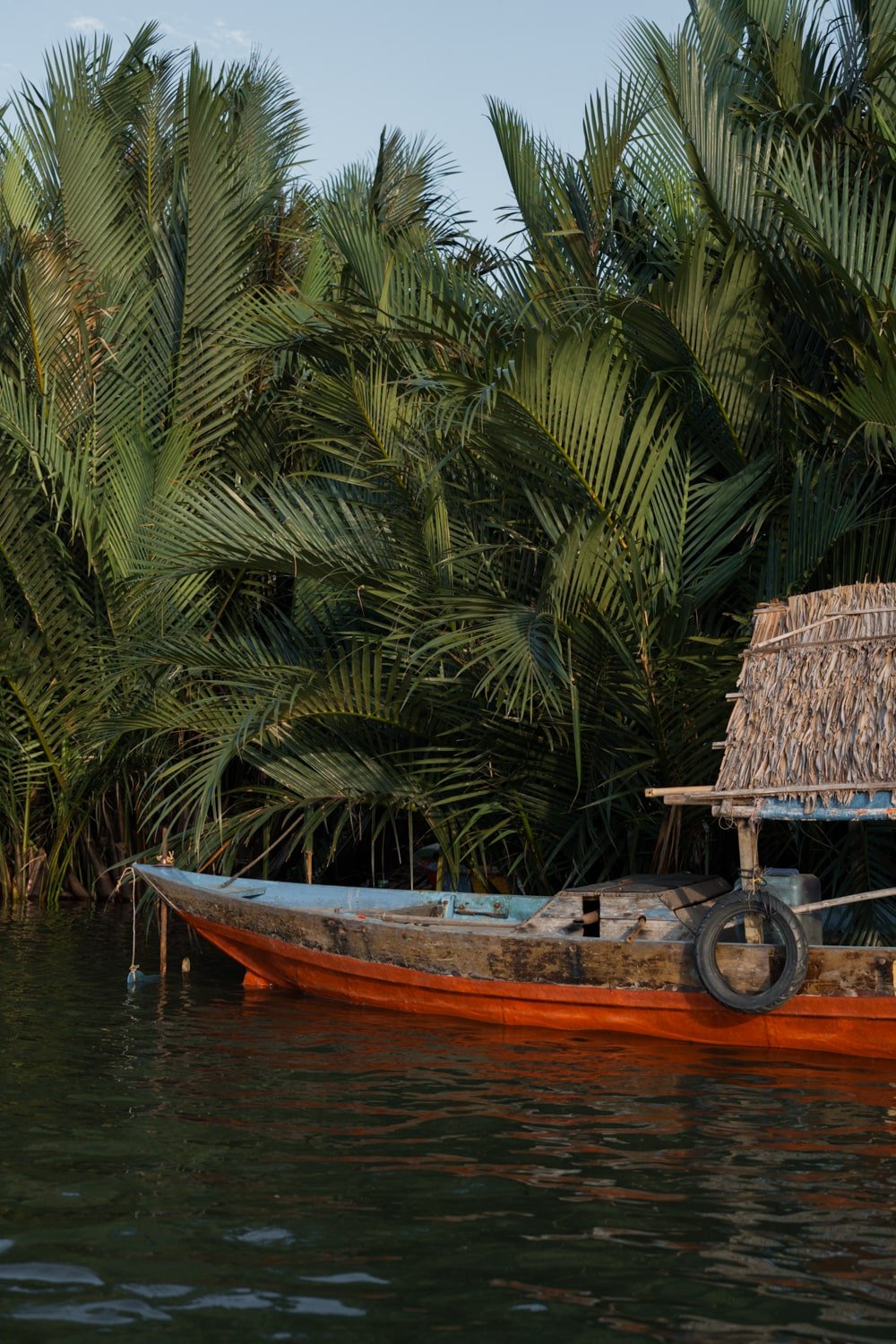
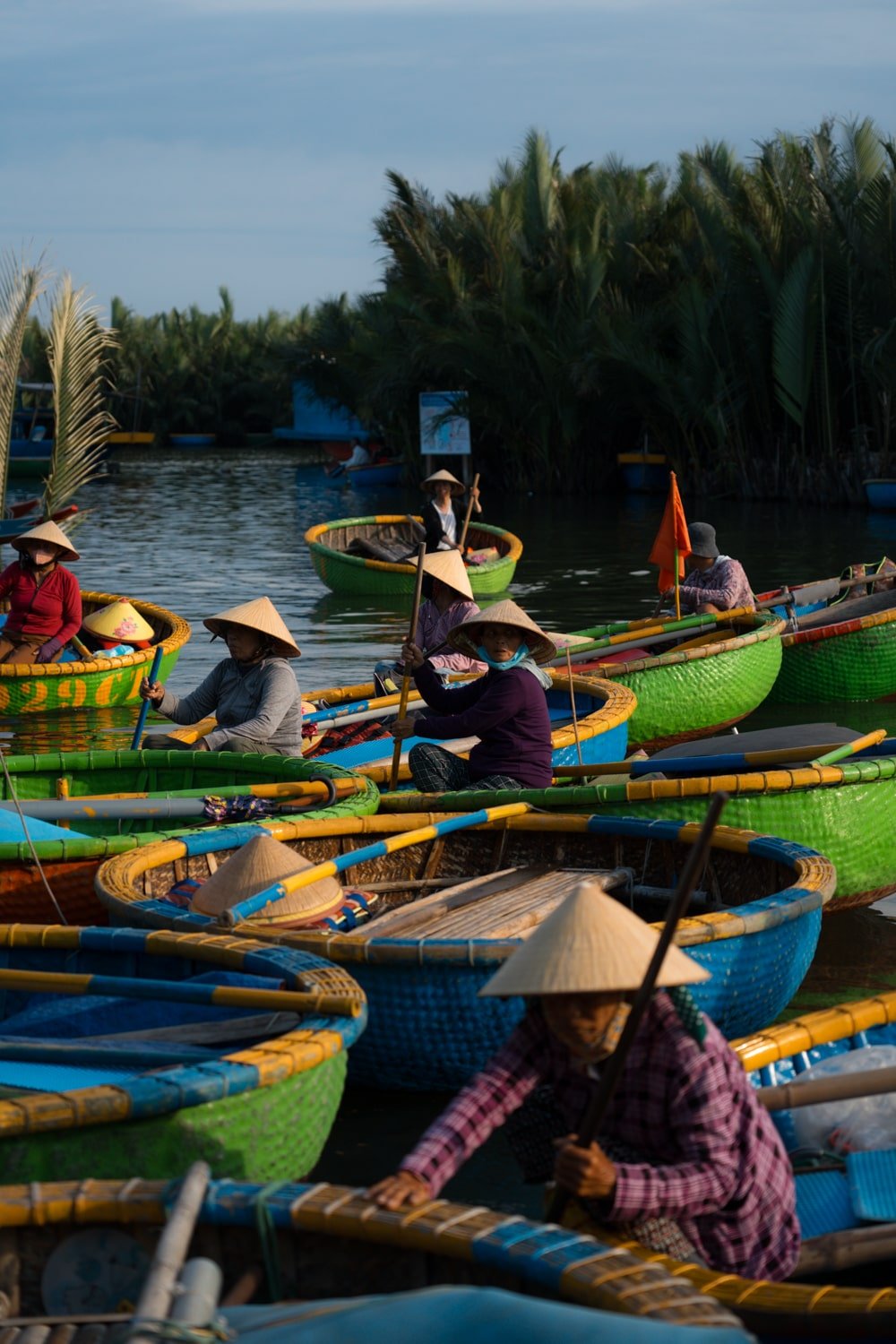

show
The Ultimate Guide to the Bay Mau Coconut Basket Boat Tour Ride Near Hoi An
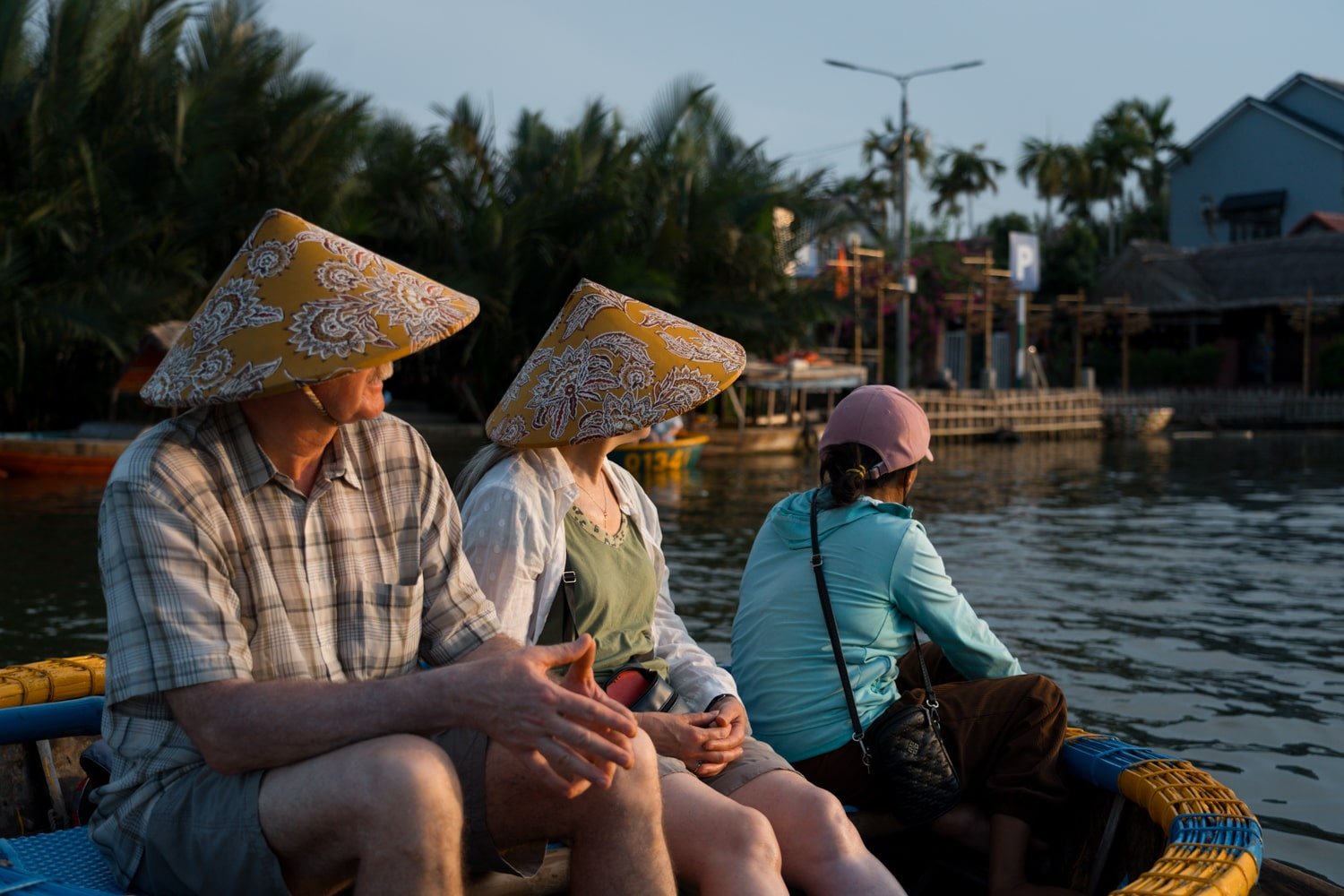

The History & Cultural Significance of Vietnamese Basket Boats
The basket boats of Hoi An have transformed from centuries-old traditions into entertainment vessels for tourists, arguably becoming the area’s number one must-do tour.
In this sense, the experience can feel like “just another tourist trap.”
And, yes, on the surface, it may seem so.
As I was confused by the showy display of the ride, I decided to step back and take a closer look at the basket boats and why they became such a phenomenon, particularly in Hoi An.
I discovered that the basket boats of coastal Vietnam are culturally significant and exemplify brilliant craftsmanship, enabling locals to fish better and maneuver in the rivers and sea.

But why have they become such a popular thing to do for tourists? It makes sense if we follow Hoi An’s history.
Hoi An, considered the Silk Road of the Sea, was a key trading port on the maritime Silk Road, linking Asia with Europe during the Champa Kingdom (2nd-17th centuries) and later during the Vietnamese Nguyen Dynasty.
Throughout this time, Hoi An was a bustling hub for silk, ceramics, spices, and other goods exchanged between East and West.
As such, local Hoi An fishermen have used the Vietnamese basket boats—handwoven from bamboo and coated with resin for waterproofing—for generations.
Their history is intertwined through centuries of maritime trade and local livelihoods—and the tour offers a very tiny experience of riding in one of these boats on the ancient Thu Bon River… with a Gangnam Style twist! 😂
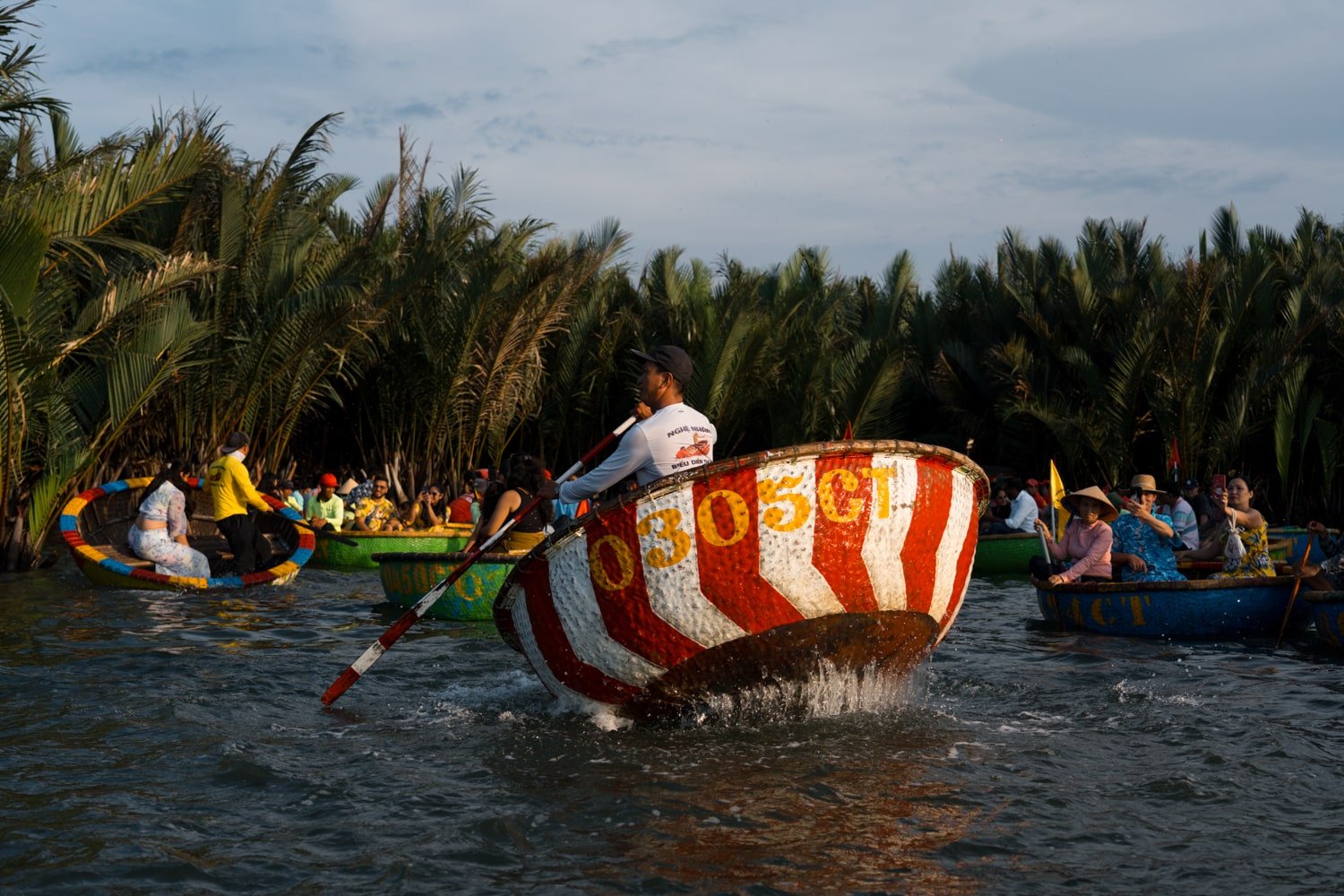
What and Where Is the Bay Mau Coconut Forest?
Hoi An’s famous coconut basket boat ride is inside the Bay Mau Coconut Forest located near Cam Thanh village, some 5km/3 mi outside Hoi An’s ancient town.
Bay Mau (literally translating to “Seven Acres”) is the historical birthplace of the Hoi An basket boats.
Local fishermen have long used them to fish along the Thu Bon River and in the nearby coastal waters.
It is said that thanks to its once-7 acres of dense grove, Bay Mau became a significant source of nourishment and natural protection for the local Vietnamese people during the French resistance.

Since wartime, and thanks to tourism development, the Bay Mau area has become somewhat of an ecotourism destination around Hoi An because of its dense clusters of coconut palms, waterways, diverse fauna, and cultural significance and preservation.
If you can think of it this way, today’s Hoi An Coconut Basket Boat Tour is an experiential, invisible bridge between the past and present.
The easiest way to get to Bay Mau for the boat experience is via a guided tour with roundtrip transport or a Grab motorcycle/car taxi from Hoi An.
What to Expect on the Hoi An Basket Boat Tour
If you think the Coconut Basket Boats experience will be peaceful, you are in for a bit of a surprise.
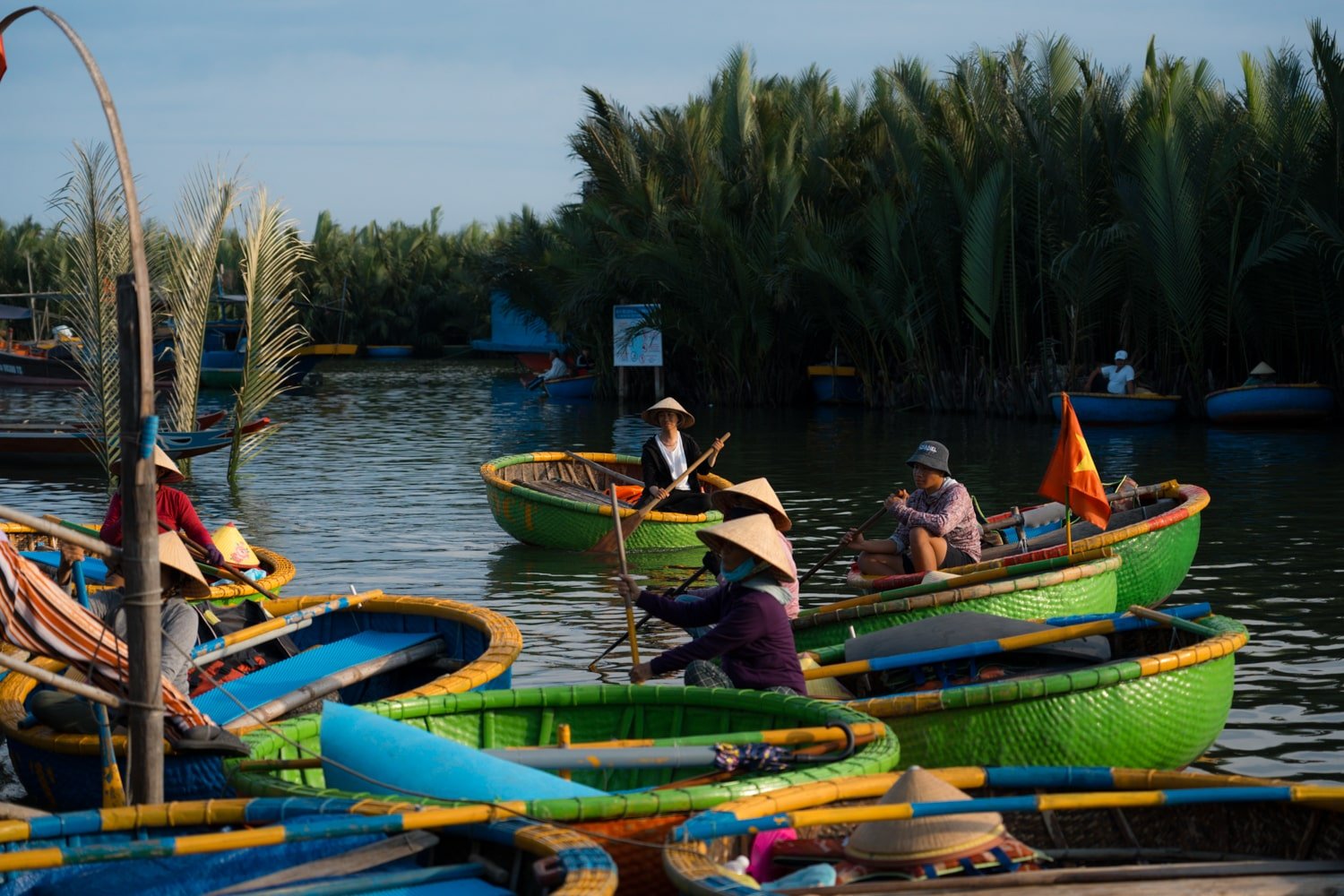
Initially, the tour starts slowly and pleasantly along the Thu Bon River, the central vein that runs through Hoi An and a once-vital trading route.
And, yes, while the bulk of the 35-50 minute tour is easy-going—with your Vietnamese rower paddling down the waterway through a dense coconut grove—you’ll eventually exit the forest, and that’s when things seem to go from 0-100.
Suddenly, there’s spinning, shouting, music, and mayhem!
A big part of the experience is witnessing (or participating, if you dare) in the full-out basket boat dances, where a local spins the basket round and round with expert ease while rocking out to Gangnam Style.
Boom-box blaring boats aside, the tour does evolve out of Hoi An’s local culture and traditional livelihoods, particularly those of the fishermen who rely on the area’s resources.

By showcasing these cultural practices, the tour helps preserve traditions while generating income for local communities.
And even though I didn’t personally appreciate the chaos of the dancing, I do see the significance and wholesomeness of the locals having fun with it. They’ve made this attraction such a steady income stream for the community; for that alone, it’s worthwhile!
Our boat guide was clapping and laughing at the performances by other boat guides—probably her long-time neighbors or even family or friends.
And that? That’s what I will remember most about the experience—our guide and her decades of experience, skill, and time spent on the water in these boats!
I wanted to do this tour because of the local insights and interactions (haha, no, not for the Gangnam Style boat parties).
After the “dance party,” the boat tour concludes with a leisurely ride back to the main dock.
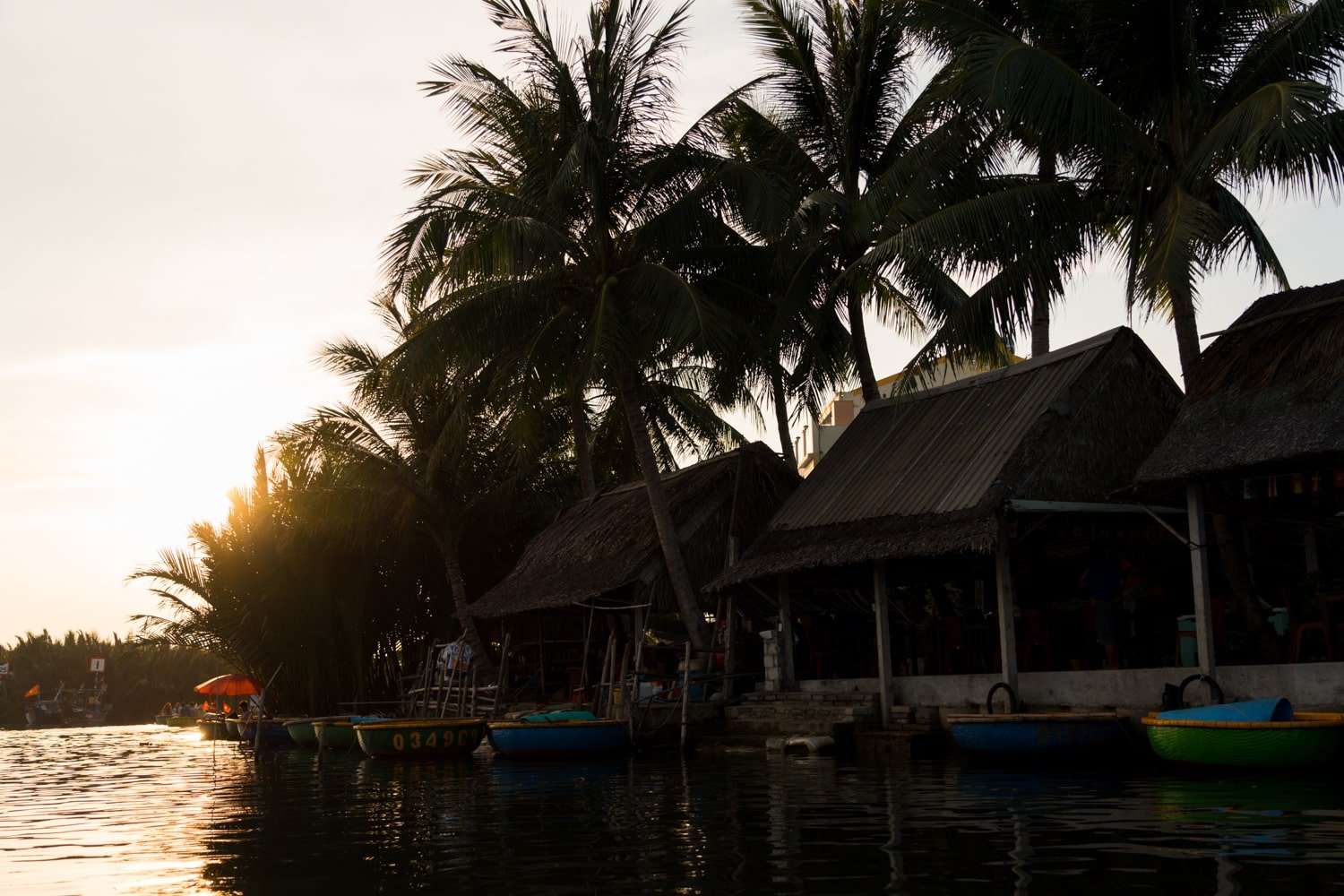
On the return journey, our guide briefly rowed to a rickety old staircase to show us crab fishing with a little rod. I don’t think every boat/guide does this, though.
Cost of the Basket Boat Rides & Tour Options
If you get a base admission ticket online with Klook or upon arrival at Bay Mau, you expect to pay only $3-4 USD or about 100,000 VND.
Most guided tours you can book online include admission and transport, costing $5-10 USD or up to 200,000 VND.
Other tour options offer package deals so you can combine two popular things to do around Hoi An.
For example, depending on your itinerary, you can combine the coconut boat experience and the Tra Que Vegetable Village or Thanh Ha Pottery Village, or even roundtrip transport from Da Nang.
Check all the tour options here! 🛶

Personally, if I did this tour again, I’d probably combine it and knock out 2 to 3 experiences at once.
Another option is this certified tour by GetYourGuide, which offers a market tour, basket boat tour, and a cooking class all in one!
Best Time to Go to Avoid Crowds
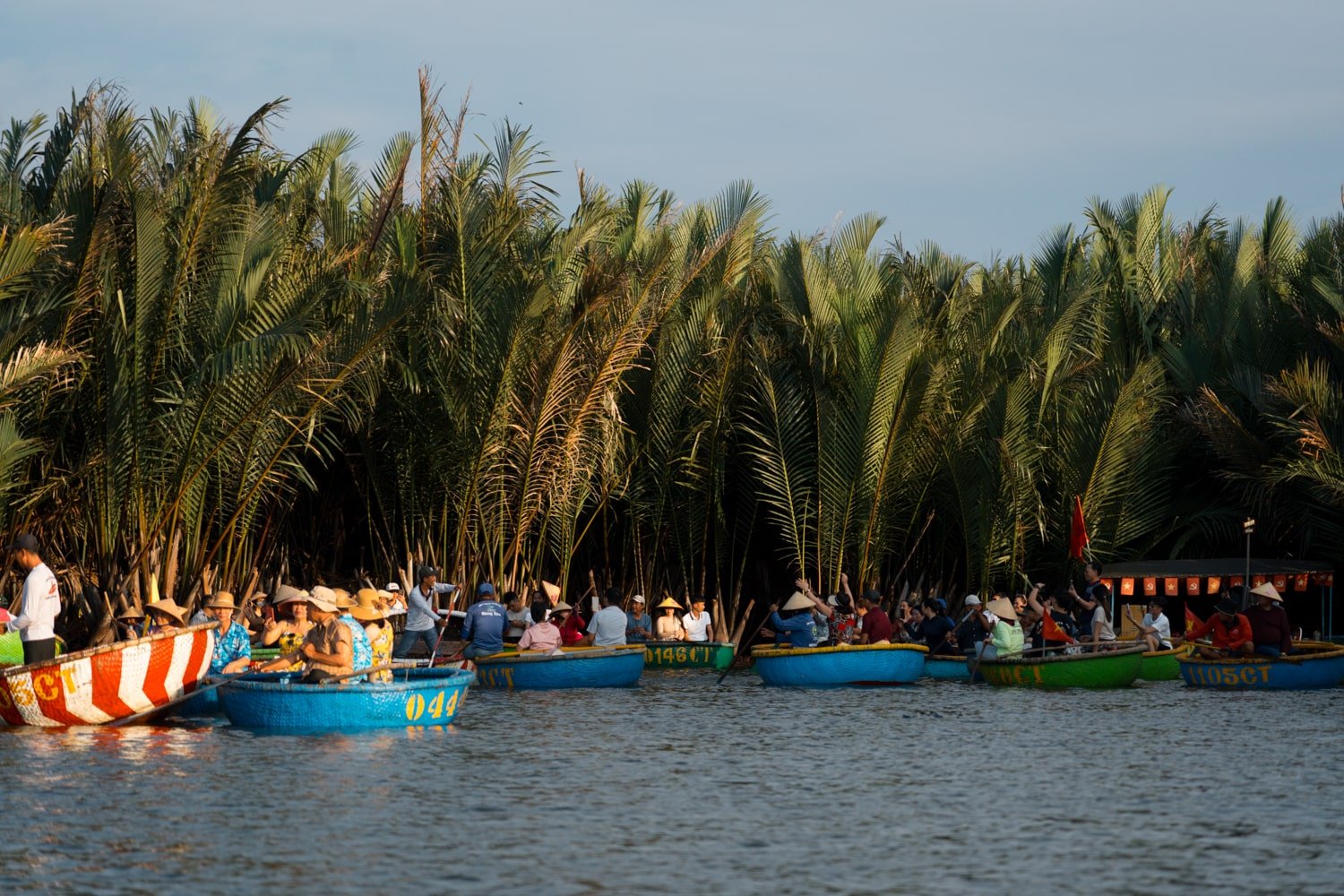
The best time to enjoy Hoi An’s coconut basket boat ride is early morning or sunset!
We went during the hour before sunset, and not only did it provide the best light, but it also helped us avoid the peak heat of the day.
Tip: That said, the tour is still outside in full sunshine with no shade (some umbrellas on the boats are provided if needed). Wear sunscreen, carry bug spray, and a hat! Packing a small day bag with you is a good idea and there’s plenty of room in the boat to store your things.
Like most lantern workshops and boat experiences, the coconut forest tour outside Hoi An gets extremely busy during weekends, peak seasons, and hours.
Avoid major Vietnamese holidays, such as Têt, if possible, and aim for March-May when the weather is ideal during the dry season.
Basket Boat Alternatives & Other Things to Do
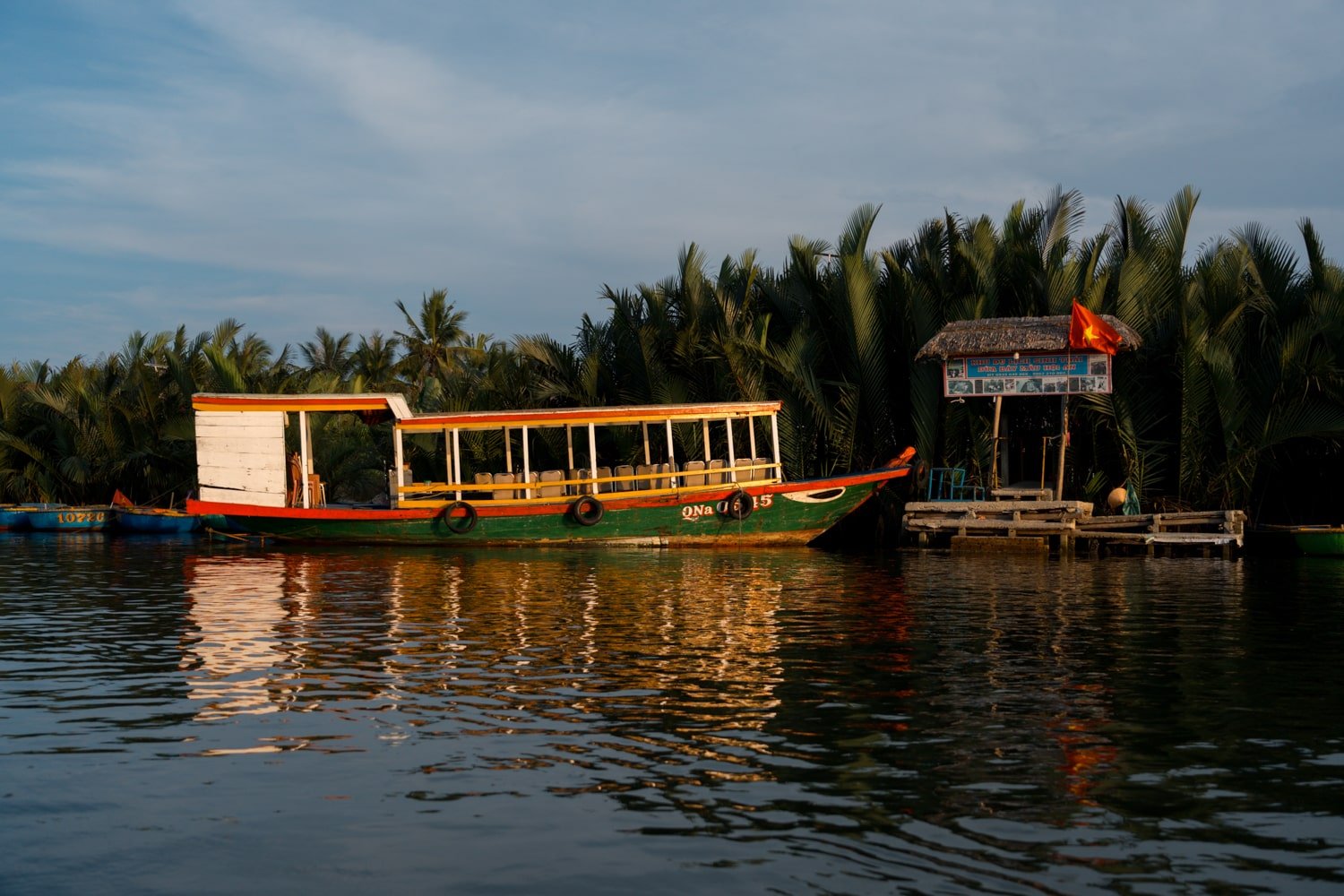
Before you head out, make the most of your trip to Bay Mau and Cam Thanh village!
As mentioned above, cooking classes are popular and can be combined with the basket boat ride. Why not learn traditional Vietnamese cuisine while in town?
Food and cooking tours are also available in Hoi An Ancient Town and in the Tra Que Vegetable Village (if you go, stop by my favorite coffee house, called Café Slow).
This area outside Hoi An is also fantastic for exploring the countryside by bike (or scooter, if you rent one!).
Bicycle tours can take you through rice paddies and local villages and sometimes involve farming experiences like rice planting.
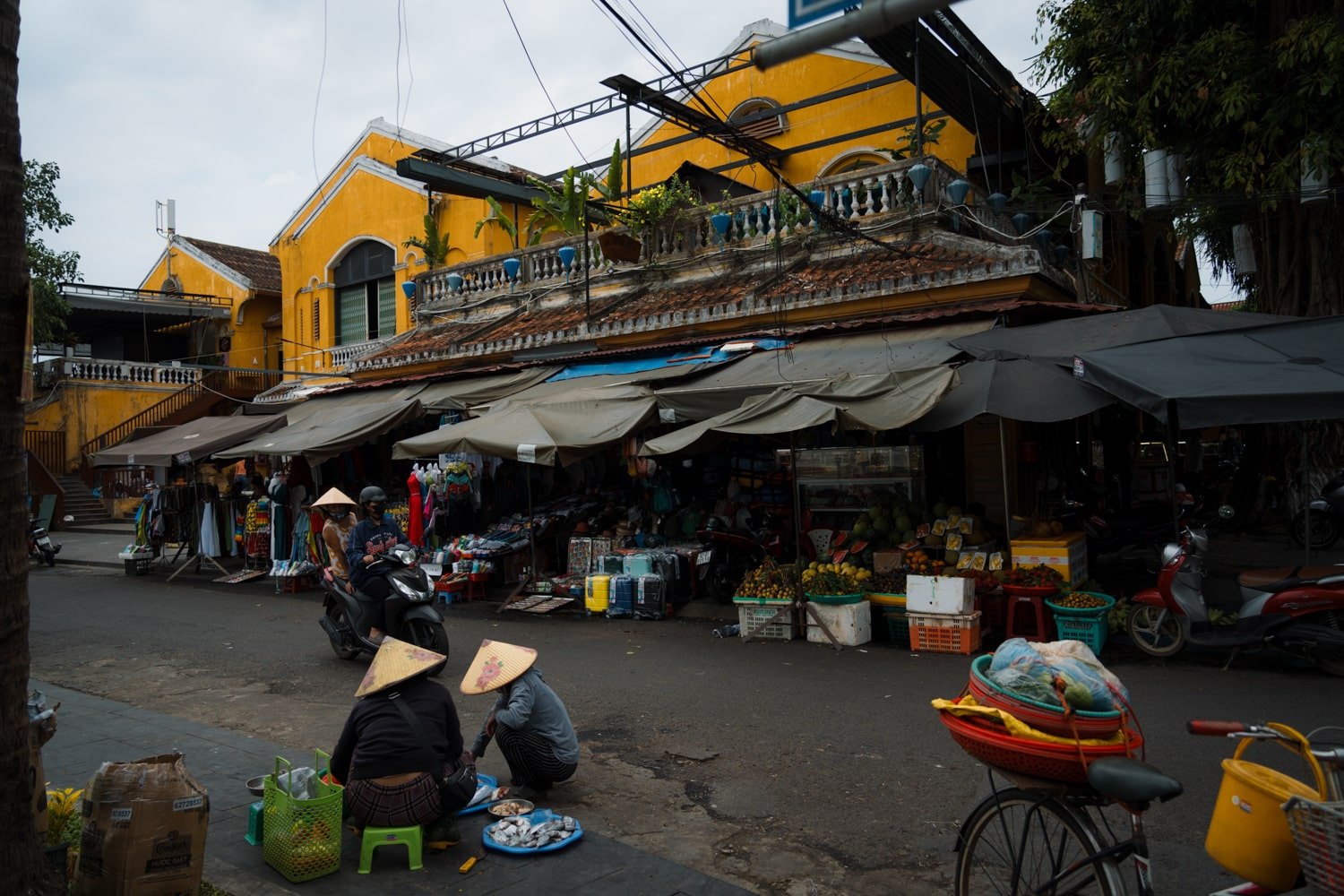
More fun things to do around here are craft workshops for pottery, lanterns, and bamboo crafts. 🏮
Oh, and don’t skip out on the beaches!
In particular, An Bang Beach and Cua Dai Beach are beautiful places to visit for a beach day and sunset.
For adventures a bit further out, check out the UNESCO-protected My Son Sanctuary, which takes about a 45-minute drive from Cam Thanh.
My Final Thoughts: Is the Basket Boat Tour Worth It?

In earnest, I was disappointed with the blaring music and overall “hype” of the boat dancing.
Many tourists come here for this viral-worthy spinning without reflecting on or appreciating the basket boats’ significance and importance in the community’s livelihoods.
At the same time, I think this type of tourism is a compromise and can still work to preserve cultural traditions and history.
Like myself, others may initially wish to visit after seeing a beautiful drone photo online or a viral video of the Vietnamese locals spinning the boats and having fun, then depart with a deeper understanding of its place and people.
Whatever your reasoning for visiting and participating in this experience, I hope your visit is meaningful and mindful, and you can leave with a deeper appreciation for these boats—the timeless symbols of Hoi An’s maritime heritage and the enduring spirit of its coastal communities.




